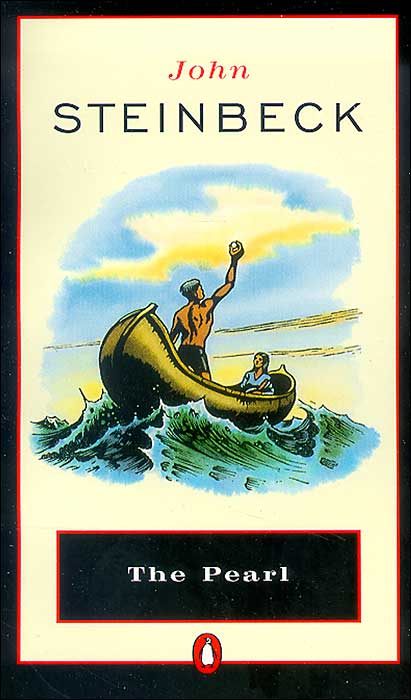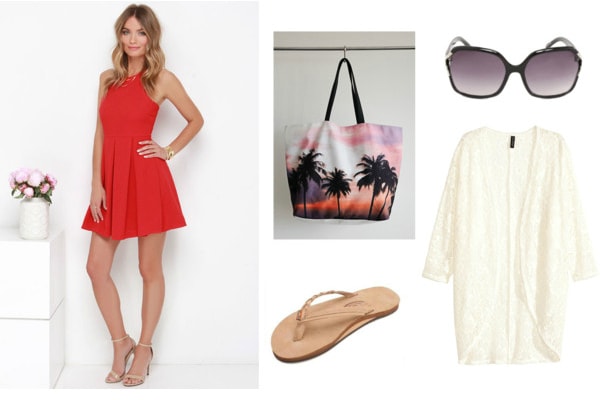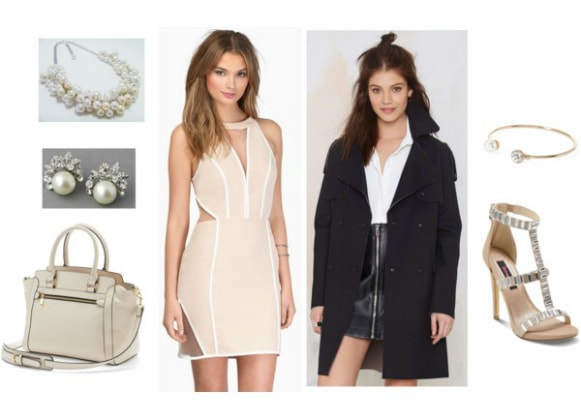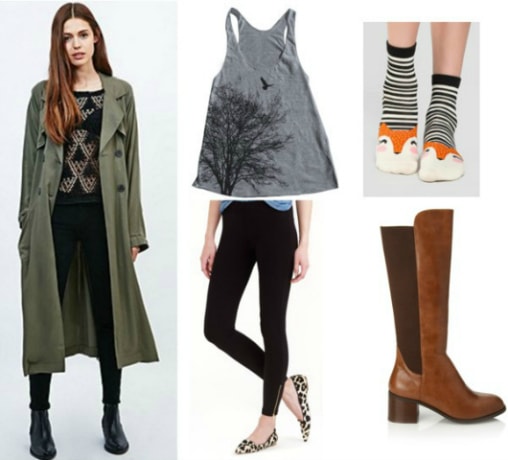Fashion inspiration can be found anywhere, and books are incredible sources for style innovation. Book-Inspired Fashion explores these treasure troves, and brings them them to you in looks inspired by vibrant characters, far away lands, brilliantly woven plotlines, and more.

Book Cover via Amazon
Wow, it’s definitely been a while since I read this novella, and it actually made me nervous to pick it up again! John Steinbeck is one of my favorite writers from the 20th century, and The Pearl’s brief length and beauty in simplicity made it a no-brainer: this is the Steinbeck book for me to cover.
It doesn’t have the sheer magnitude of size that some of his other works, like East of Eden (my favorite Steinbeck book!) or The Grapes of Wrath have, but it doesn’t need a huge cast of characters or cross-generational conflict to deliver its powerful social message. Let’s dive in! (Pun intended.)
Table of Contents
Reading Between the Lines
As mentioned, this book was written by Nobel Laureate and Pulitzer Prize winner John Steinbeck, whose books have forever shaped American literature. One of the best-known authors of the 20th century, Steinbeck’s influential writings often carry moral undertones, but ultimately focus on human nature– particularly the darker side of it. He is also considered a beloved Californian author because of the fact that most of his books are set in California, where he was born and raised.
The Pearl was published in 1947, after he had already established himself as a well-known writer, and is a quick read at under 100 pages. The plot is fairly simple, following protagonist Kino, his wife Juana, and infant son Coyotito. They live a quiet, routine life, with Kino providing for them as a fisherman. Despite their clear poverty from the very beginning, they are not bitter about their social situation. This changes, however, when Kino finds the pearl– worth more than anything he and Juana could ever dream of owning.
What starts out as a fortuitous discovery turns into exploitation, dishonesty, and tragedy. I don’t want to spoil anything, but the events following, however disheartening, culminate in a single shocking event that has left a huge impact on me ever since I first read the scene. It was unexpected (for me, anyway) and devastating, and the frenzied emotions that had bubbled up inside of me by that point truly made me feel. It’s the end of this short story that brings everything full circle, but the entire journey is truly an emotional ride.
While The Pearl is often overlooked by Steinbeck’s more famous novella Of Mice and Men, both tales are stunning reflections of the darkest aspects of human interaction, and I am so glad that both were in my school curriculum. The moral scrutiny that Steinbeck offers is nowhere near dominant enough to seem like he’s preaching, but he has a startling ability to deliver a concise, hard-hitting message every time.
Since Kino and his family are victims of their environment, both natural and social, I have created three looks based on the physical setting and its effects on the family: their humble home by the sea, the pearl itself, and the eventually menacing surroundings of the cliff-side cave.
1. Perfect Among Mornings
“The dawn came quickly now, a wash, a glow, a lightness, and then an explosion of fire as the sun arose out of the gulf. Kino looked down to cover his eyes from the glare… It was a morning like other mornings and yet perfect among mornings” (Steinbeck).

Product Info: Dress – Lulu’s, Cardigan – H&M, Shoes – Rainbows, Bag – Forever 21, Sunglasses – Moddeals
This scene comes right at the beginning of the book, and is a bit like the calm before the storm. It depicts the content, everyday lifestyle of Kino and Juana, who have woken up right before dawn, which allows them to enjoy the bright colors of the rising sun above the water. This comes right before the first major conflict of the story, in which a scorpion stings their baby Coyotito right before their eyes, and destroys that image of the perfect morning.
This very much sets up the significance of the ocean and the importance of natural rhythm and life. Everything the family needs is provided by the sea and Kino’s boat, and there is the sense that simplicity and routine is what maintains their content mode of living. This, of course, will soon be disrupted with the appearance of the pearl.
This outfit showcases the bright red of the “explosion of fire,” but the dress remains simple since the basic cut doesn’t have any frills. The tote is a fun beach bag reflective of the ocean’s vicinity, and I threw in the flip-flops because, like Kino’s canoe, they are reliable but unpretentious. They are also extremely comfortable, which is awesome in a practical sense.
I included the cardigan because it is, after all, usually a bit chilly at the crack of dawn, and the sunglasses are a must-have for when the sun’s rays are glaring into your eyes.
2. The Great Pearl
“The lip-like flesh writhed up and then subsided. Kino lifted the flesh, and there it lay, the great pearl, perfect as the moon. It captured the light and refined it and gave it back in silver incandescence. It was as large as a seagull’s egg. It was the greatest pearl in the world” (Steinbeck).

Product Info: Dress – Tobi, Coat – Nasty Gal, Shoes – Target, Bag – Kohl’s, Jewelry: Necklace – Etsy, Earrings – Etsy, Cuff – Forever 21
I had not planned on using the actual scene of the pearl’s discovery, but it turned out to be a better representation of the book’s setting than I had anticipated. At this point, Kino still has a strong connection to the natural environment. The pearl, of course, is a product of the ocean that is Kino’s livelihood, but the comparisons to both the moon and a seagull’s egg establishes the sheer prominence of nature for Kino.
There are several different elements to this outfit, and a lot of imagery and symbolism to work with. To begin, this outfit is much more formal than the other two looks, since the eponymous pearl is worth untold value and elevates Kino, socially, to the attention and privilege (in theory) of many higher class people in society.
The flesh-colored dress represents the outer layer Kino had to physically cut through in order to reach the actual pearl, and the cut of the dress is a bit daring because this is the point when Kino becomes more daring and wilder– certainly more likely to take risks. The white purse adds a luxurious touch (as does the classic black trench), but has a subtle snakeskin design that foreshadows, in a way, the dangers that the pearl brings.
The pearl jewelry is pretty self-explanatory, and I settled on neutral shoes that are embellished but still complement the dress without taking anything away from the other accessories.
3. Evils of the Night
“And the evils of the night were about them. The coyotes cried and laughed in the brush, and the owls screeched and hissed over their heads. And once some large animal lumbered away, crackling the undergrowth as it went. And Kino gripped the handle of the big working knife and took a sense of protection from it” (Steinbeck).

Product Info: Jacket – Urban Outfitters, Tank – Etsy, Leggings – J. Crew, Boots – Forever 21, Socks – Francesca’s
This scene appears in the last, climactic chapter of the novella and, to me, is the very opposite of the first quote at the beginning of the book. Nature is described like a powerful force in both scenes, but here, nature and the animals do not represent a part of everyday life, and instead offer a very threatening element. Kino no longer gains solace from his surroundings, but needs to feel protection from his knife– a man-made object– instead.
As I have said before, I don’t want to spoil anything major, but this scene definitely winds you up for the upcoming violence and brutality that is about to occur and change Kino’s life forever. This is generally just a very dark scene that demonstrates the distance that has grown between Kino and nature itself, with the pearl as an active agent in this shift.
Nearly all of the colors in this outfit are dark, but they are also all colors that I envision would be present outdoors after nightfall– dark green, black, brown, etc. It’s also a very outdoors-oriented look, as evident in the graphics I’ve chosen: a dark tree print on the tank and the (adorable!) foxes on the socks.
This overall outfit is also much more casual and practical than the other two, because at this point, Kino is willing to do essentially anything in order to escape successfully with his wife and son. Given that they are all hiding in a cliff-side cave, there’s no room for unnecessarily accessories, which is a huge contrast from the previous outfit, in which Kino first found the trouble-seeking pearl.
There’s also a general dark cast mood-wise in this outfit, and it’s clear in the little details, such as the zippers on the leggings. This is very intentional, because the end is truly shocking and pretty devastating to me. But as promised, I’m not revealing anything– read the book to find out how this story ends!
Final Words
The Pearl is remarkably moving; it’s as if Steinbeck truly understood the workings of human emotion. If you’ve read and enjoyed any of his other works, The Pearl will give you Steinbeck’s signature heavy-hitting, gut-wrenching stories without having to invest a ton of time a longer, more complex book.
I think it’s astounding how well Steinbeck can craft a quintessentially Western classic while incorporating the significance of both cultural identity and tradition– he does not, in fact, idealize any one type of figure, and instead attempts to follow the lives of who he deems “ordinary” people. Whether or not they are actually ordinary is another matter, but there’s always that element of relatability, especially with the darker universal themes of greed, pride, lust, and more.
If you haven’t been required to read Steinbeck in school yet, or have wanted to pick up The Grapes of Wrath for some time now but are intimidated by its dense complexity, try out The Pearl for a briefer, simpler glimpse of Steinbeck’s world.
Next time, I’m going to cover another book whose movie adaptation is much better known. Even though I saw the movie before I read the book, my article will (as always!) deal solely with the novel.
It was really hard to pick just one word to use as a hint without being too obvious or obscure. So, I just chose a word that is a good visual representation of the world of the protagonist.
Hint: Kimono
Your Thoughts?
Did you ever have to read Steinbeck in school? Have you read The Pearl? What do you think of these three looks? Let us know in the comments below!

Memoirs of a Geisha is next 😛